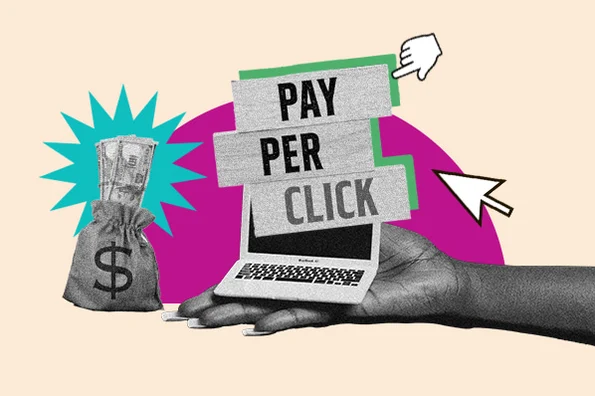Hello!
Evergreen PPC ad campaigns are amazing for your business. They’re like low-hanging fruit that you can pluck for a nice snack; you continue benefiting from them long after you have published them for the first time.
However, if you notice a significant or sudden decline in performance, it may be time to assess and adjust. In this blog post, we’ll explore ways to improve and rejuvenate these valuable campaigns.
But, first things first:
What are Evergreen PPC Ad Campaigns?
 Evergreen PPC campaigns are always running and target keywords central to your brand, whether you’re offering services or products.
Evergreen PPC campaigns are always running and target keywords central to your brand, whether you’re offering services or products.
These campaigns generally have consistent year-round search demand with occasional spikes, though they are primarily driven by factors unrelated to seasonality. They consistently receive a good volume of searches every month.
For instance, consider a rental store offering designer suits year-round and holiday-themed costumes during Christmas. The keywords for rental suits are considered “evergreen,” as they are the store’s main offering and searched for throughout the year.
Searches for Santa costumes are related to the seasonal campaign and are not considered evergreen.
What are Stale PPC Ad Campaigns?
 A stale campaign is a long-running campaign that no longer shows improvement in key performance indicators (KPIs) such as CPA (Click per Action or Cost Per Action), ROAS (Return on Ad Spend), CPL (Cost per Lead), , and others relevant to the specific campaign.
A stale campaign is a long-running campaign that no longer shows improvement in key performance indicators (KPIs) such as CPA (Click per Action or Cost Per Action), ROAS (Return on Ad Spend), CPL (Cost per Lead), , and others relevant to the specific campaign.
Why do campaigns become stale? It may be due to a lack of optimization efforts or a lack of incoming data for decision making, among other reasons.
These campaigns may result in lower traffic and poor conversion quality, and they may become increasingly costly to drive conversions.
Why are Evergreen PPC Ad Campaigns so Important for your Business?
Evergreen PPC campaigns frequently contribute the largest share of a business’s weekly traffic.
They generate traffic consistently and make up the foundation of a company’s core PPC marketing strategy, with a large percentage of your clicks and conversions coming from them.
 If you are a seasoned PPC professional, you may have invested several weeks in constructing your evergreen campaigns.
If you are a seasoned PPC professional, you may have invested several weeks in constructing your evergreen campaigns.
During this time, you would have made additions, optimized and trimmed the campaigns to ensure they performed optimally and delivered the required conversions to meet your marketing needs.
But once your evergreen campaigns were running, you would have moved onto new campaigns, seasonal ones, and the like. Over time, the marketplace has evolved, rivals have shifted, and your strategies have transformed.
PPC campaigns need to be managed and optimized in order to remain effective. Neglecting them for too long can lead to a decline in performance.
It’s highly likely that your evergreen campaigns will generate the majority of your significant digital results – conversions, sales, impressions, clicks, etc. – due to the fact that they run continuously and likely encompass a small set of keywords responsible for most of your critical KPIs.
However, they’re like other campaigns, and must be maintained over time.
How to Improve Your Evergreen PPC Ad Campaign Performance
Wake Up The Algorithm
Stimulating the algorithm in control of your evergreen campaign is crucial for reactivating optimization.
 You can start by making high-level optimizations to revive your campaign performance:
You can start by making high-level optimizations to revive your campaign performance:
- Increase the number of conversion actions.
- Modify bid strategy.
- Expand keyword list.
- Revise ad copy or overhaul it entirely.
- Modify device bid adjustments.
- Focus on optimizing for value.
You can enhance your ad creative, upgrade your landing page, or optimize the mobile shopping experience on your retail site, all of which will aid the performance of your automated bidding algorithm.
You don’t really have to do it all. Revitalize your algorithm by implementing a couple of these methods at a time and monitor the results. Hopefully, you will start to see the needle move.
Consider Smart Bidding
 In the past, using things like modified broad-match keyword match type or manual CPC bidding was a widely accepted approach that produced better results compared to Google’s automated “Smart” Bidding.
In the past, using things like modified broad-match keyword match type or manual CPC bidding was a widely accepted approach that produced better results compared to Google’s automated “Smart” Bidding.
The broad-match keyword paradigm was discontinued in 2021, leaving PPC managers to explore other options, including Google’s Smart Bidding strategies.
Now that we’ve had over a year of trying Google’s options, it’s become clear that smart bidding is worth exploring. Google has improved its automated bidding, yielding promising results in many campaigns.
By using Smart Bidding strategies in your evergreen campaigns, particularly if you use broad match keywords, you allow Google to harness the power of its AI-driven algorithms and vast amounts of customer data to find the most relevant audience.
Ensure that your campaigns are in compliance with bidding strategy requirements, since Smart Bidding, despite its advanced algorithms, needs data to function optimally. Providing more conversion data leads to better results.
Additionally, ensure your budget is adequate to drive sufficient conversions each month for the success of your Smart Bidding campaign.
Enable Tracking for Offline Conversions
 Incorporating Offline Conversion Tracking (OCT) could revitalize stagnant, evergreen PPC campaigns run on Google.
Incorporating Offline Conversion Tracking (OCT) could revitalize stagnant, evergreen PPC campaigns run on Google.
Setting up Offline Conversion Tracking (OCT) can be challenging. However, despite the technical difficulties, the benefits are substantial. According to Google, OCT has the potential to increase cost efficiency by up to 30%.
One great part of using Offline Conversion Tracking (OCT) is that it’s cost-free. There’s no need to increase bids, allocate more budget, or put in extra effort.
By simply furnishing Google with more data about your customers, you can see significant improvements in your evergreen campaigns, even those that have been running for quite some time.
Revisit Keywords
 A common oversight made by even seasoned marketers is limiting keyword research to the account setup phase.
A common oversight made by even seasoned marketers is limiting keyword research to the account setup phase.
The popularity of search terms is constantly changing, and there may be new, high-volume keywords to target. Revising your PPC strategy to include these keywords can result in increased impressions and a higher click-through rate.
Another common reason why many PPC campaigns fall short of their goals is an excessive number of keywords.
The Digital Marketing Institute reports that an average PPC campaign generates sales from only 12% of its keywords. To improve your campaign’s results, focus on enhancing keyword quality, not keyword quantity.
 Three key elements that determine keyword quality are:
Three key elements that determine keyword quality are:
- Relevance of keywords to ad copy
- Click-through rate (CTR)
- Landing page experience.
Here are some tips to enhance the quality score of your keywords:
- Ensure that your ad copy aligns with the search objective of your keyword. Craft headlines that address the needs of your target audience.
- Determine the number of clicks your selected keywords receive. High CTR keywords can drive traffic and boost conversion rates.
- Utilize the Dynamic Text Replacement (DTR) feature to match your ad’s keyword with your landing page content. This will provide personalized content to your audience for each ad.
Additionally, it’s crucial to thoroughly review and take a deep dive into your list of negative keywords. Negative keywords can significantly conserve your campaign budget by preventing your ads from showing for irrelevant searches.
It’s all about data, data, data
Optimizing search campaigns, including evergreen PPC campaigns, can be achieved by better leveraging your data.
 This data can be used to gain a competitive advantage for a single campaign or it can be used to build comprehensive customer profiles..
This data can be used to gain a competitive advantage for a single campaign or it can be used to build comprehensive customer profiles..
Google Ads collects a wealth of information on users who interact with your ads. This data can be easily accessed within Google Ads without the need for additional resources.
By collecting and analyzing all relevant data, you can make informed optimization decisions to revitalize your evergreen, stale campaigns.
This data can be found in two key places: The Google Ads platform provides access to a vast treasure trove of information about customer behavior and preferences through its side menus.
The information available through Google Ads can reveal a wealth of knowledge simply by examining the data provided in its various campaign menus. Delving deeper into the platform can lead to even greater insights.
 You can find that data here:
You can find that data here:
- Shared Library > Audience Manager > Your Data Insights under Tools & Settings
- Attribution and its sub-menus in Measurement under Tools & Settings
- Diagnose Keywords > Run Diagnosis accessed through the Three Dots in the Keyword Tab of the Account, Campaign or Ad Group Tab.
Look At Your Landing Page
What was working earlier is not working now. It’s time to delve deeper into your landing pages to uncover the reason for the lack of conversions. A great landing page is crucial to PPC campaign success.
 It may be time to reassess the evergreen campaign’s landing page and devise plans to enhance it, such as reducing text, updating social proof, incorporating testimonials, modifying copy, or reducing information requested in forms from prospects.
It may be time to reassess the evergreen campaign’s landing page and devise plans to enhance it, such as reducing text, updating social proof, incorporating testimonials, modifying copy, or reducing information requested in forms from prospects.
We often find that minimizing text but making it engaging and straightforward is effective.
Your landing page should not be used for writing the next great American novel. An overload of text makes the page lengthy, dull, and difficult to read, especially if jargon is utilized. The copy must clearly communicate the reasons for conversion.
For maximum ROI and expert help with PPC campaigns, reach out to SevenAtoms today.
Also read:
- How to Use Work from Anywhere to Your Company’s Advantage
- Unleashing the Power of Technology: Enhancing HR Practices with Psychometric Testing
- Hybrid Cloud Solutions – The Future of IT
Thank you!
Join us on social media!
See you!






